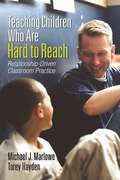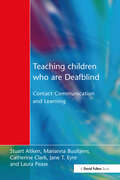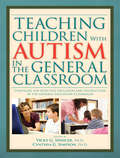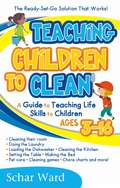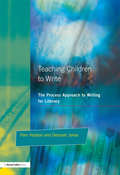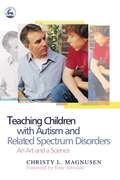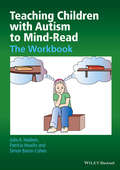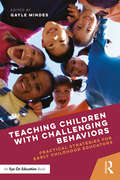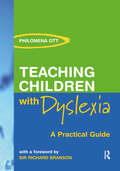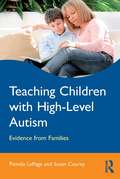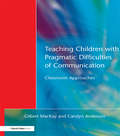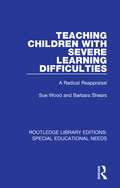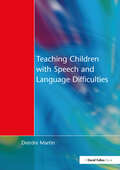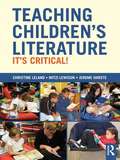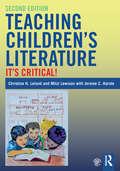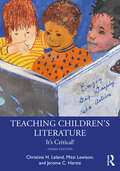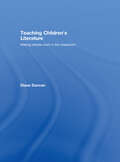- Table View
- List View
Teaching Children Who Are Hard to Reach: Relationship-Driven Classroom Practice
by Torey Hayden Michael J. MarloweCreate lasting, positive change for our most troubled students! How do you move beyond traditional classroom management to create a learning environment that engages our hardest-to-reach students—students who may be struggling due to emotional disturbances, disabilities, or environmental circumstances? Marlowe and Hayden have the answer: through a relationship-driven classroom. With the help of their book, you will: Gain a meaningful understanding of troubled students and how to reach and teach them Learn how to change inappropriate behavior rather than just control it Develop the essential skills for building successful classroom relationships Become more reflective about teaching and learning with challenging children
Teaching Children Who are Deafblind: Contact Communication and Learning
by Catherine Clark Stuart Aitken Marianna Buultjens Jane T. Eyre Laura PeaseFirst published in 2000. Routledge is an imprint of Taylor & Francis, an informa company.
Teaching Children With Autism in the General Classroom
by Vicky G. Spencer Cynthia G. SimpsonSuccessful strategies for educating students with autism in the regular classroom. Recent special education legislation has led to a rise in inclusion classrooms, where students with special needs, including autism spectrum disorders, are taught alongside their nondisabled peers. Teaching Children with Autism in the General Classroom provides an introduction to inclusionary practices that serve children with autism, giving teachers the practical advice they need to ensure each student receives the quality education he or she deserves. Promoting field-tested strategies and techniques, this book offers teachers sound advice for creating a classroom environment conducive to learning success for children with autism spectrum disorders. The easy-to-use tips and tools included also aide teachers in organizing and managing their classrooms to maximize instruction for students of all ability levels. Detailed resource guides and concise overviews of special education legislation also are provided to give general education teachers a solid background of knowledge about autism and the needs of students with the disorder.
Teaching Children and Adolescents with Special Needs
by Judy L. Olson Jennifer C. Platt Lisa A. DiekerWith collaboration so vital to today's educational arena, this thorough, well-organized, highly readable text concentrates on the general process of teaching—the basic “how to do it”—to help prospective teachers of children with mild disabilities in grades K–12 learn to work effectively with students, other teachers, and families. Basing coverage on their extensive experience, the authors present practical, research-based teaching strategies that relate to everyday occurrences in schools; provide motivating, experience-based activities; and offer numerous detailed lesson plans. Their personal, conversational writing style makes even complex concepts accessible, while their extensive coverage gives readers a solid understanding of what works and what doesn't in both special education classrooms and inclusive settings. For future teachers of elementary school students with mild disabilities and learning problems.
Teaching Children and Young People with Special Educational Needs and Disabilities
by Ms Sarah Martin-DenhamAll teachers are expected to have a clear understanding of the needs of all pupils and be able to use and evaluate distinctive teaching approaches to engage and support their entire class. But how do you actually teach and work with young people in an inclusive way? This book is your ultimate guide with chapters on: Your first day in a specialist provision Teaching, Planning and Assessment Working in partnership As well as material on specific conditions which covers all areas of exceptionality. This book gives you the knowledge and practical advice you really need to help you teach children from 0-25 with special educational needs and disabilities.
Teaching Children and Young People with Special Educational Needs and Disabilities
by Sarah Martin-DenhamAll teachers are expected to have a clear understanding of the needs of all pupils and be able to use and evaluate distinctive teaching approaches to engage and support their entire class. But how do you actually teach and work with young people in an inclusive way? This book is your ultimate guide with chapters on: Your first day in a specialist provision Teaching, Planning and Assessment Working in partnership As well as material on specific conditions which covers all areas of exceptionality. This book gives you the knowledge and practical advice you really need to help you teach children from 0-25 with special educational needs and disabilities.
Teaching Children to Clean: The Ready-Set-Go Solution That Works!
by Schar WardThis book contains step-by-step instructions for teaching children and teenagers to clean an entire house. Plus many other life skills such as doing laundry, loading a dishwasher properly, and making a bed. Cleaning is not an option, it's a necessity! If your child doesn't learn, it'll plague them the rest of their lives. According to the latest research, teaching your child to clean may be the most important thing you ever do for them! You want your child to learn basic life skills, but finding the time for accomplishing this seems to get more difficult each day. What's the answer? A new approach, that practically does it for you! You'll find it in these pages and even more: * The research on children & cleaning * Proven tactics to get the job done * Chore charts for every age * Room evaluations for easier cleaning * What tools they need * Safe green cleaning solutions, you can make yourself * Checklists for detailed cleaning in very room * How to clean appliances * How to do laundry, set the table and everyday chores * How to take care of pets * Fun cleaning games. Knowing how to take care of yourself in your everyday environment is a skill no one should be without!
Teaching Children to Write
by Deborah Jones Pam HodsonA recent OFSTED report identified the fact that, while many teachers were confident about their teaching of reading, 'too many are neglecting the teaching of writing in the Literacy Hour'. This book, building on the process approach adopted by both National Literacy Strategy and National Curriculum 2000, addresses the fundamental question, 'How do you teach writing?' / Pam Hodson and Deborah Jones provide teachers with, practical strategies, support through a clear and concise rationale, and explicit explanation of the different stages of the writing process. / This theoretical perspective is the basis of differentiated writing frames provided for the classroom use of teachers and pupils alike. Thus invaluable support is given to teachers and student teachers of writing across a wide range of genres throughout Reception, Key Stages 1 and 2, and in the early secondary years.
Teaching Children with Autism and Related Spectrum Disorders: An Art and a Science
by Anthony Attwood Christy MagnusenBased on twenty-five years of teaching and working with children who have Autism Spectrum Disorders (ASDs), Christy L. Magnusen contends that it is those teachers who can blend the 'science' of education methodology with the 'art' of teaching who are best able to reach these children. Examining both these aspects of teaching, she takes a fresh look at established and more recent teaching methods such as structuring spaces, emphasizing language and planning strategies for transition and generalization, and then explores the art of implementation: why, when and how these techniques should be applied. By highlighting workable solutions to everyday problems, and emphasizing that teachers need to understand techniques and have the ability to adapt them to the situation that faces them, this book will be invaluable to all those involved in teaching children with ASDs.
Teaching Children with Autism to Mind-Read
by Simon Baron-Cohen Julie A. Hadwin Patricia HowlinThis workbook expands upon the authors? Teaching Children with Autism to Mind-Read: A Practical Guide to present the most effective approaches, strategies, and practical guidelines to help alleviate social and communication problems in individuals with Autism Spectrum Disorders (ASD).Complements the best-selling Teaching Children with Autism to Mind-Read: A Practical Guide for use in practical settingsAnswers the need for more training of professionals in early interventions for children assessed with ASD called for by the National Plan for AutismWritten by a team of experts in the fieldCovers issues such as how to interpret facial expressions; how to recognize feelings of anger, sadness, fear and happiness; how to perceive how feelings are affected by what happens and what is expected to happen; how to see things from another person?s perspective; and how to understand another person?s knowledge and beliefs
Teaching Children with Challenging Behaviors: Practical Strategies for Early Childhood Educators
by Gayle MindesTeaching Children with Challenging Behaviors provides early childhood educators with a guide to developmentally appropriate practice for working with children who exhibit challenging behaviors, as well as perspectives for experienced teachers to reflect upon best practices in today’s complex world. This highly practical book addresses systemic issues such as classroom management techniques; social, emotional, and behavioral support strategies; curriculum, assessment, and utilization of technology; and bridging the existing gap between mental health providers, families, and early childhood professionals. Written in nontechnical language with support from current research, this book will help you navigate the sometimes treacherous terrain of teaching children with challenging behaviors.
Teaching Children with Dyslexia: A Practical Guide
by Philomena OttTeaching Children with Dyslexia is essential reading for any teacher, Special Educational Needs Co-ordinator or teaching assistant who wants an insider's account of what dealing successfully with dyslexia entails.Written by one of the most well-regarded practitioners in the field with over twenty-five years' experience, this book is packed full with photocopiable exercises, activities and recommendations for resources, tests, teaching methods, advice and suggestions for strategies and techniques that are instantly transferable to classroom environments. This essential teaching companion includes chapters on: how to spot dyslexia screening and assessment tests why it does not have to be hell to learn to spell strategies for success for reluctant writers meeting the challenge of dyslexia in adolescence. Written specifically to bolster teachers' confidence and empower them with the key to unlocking literacy problems in their most challenging pupils, this resource book should be on the shelf of every staff room.
Teaching Children with High-Level Autism: Evidence from Families
by Pamela LePage Susan CoureyTeaching Children with High-Level Autism combines the perspectives of families and children with disabilities and frames these personal experiences in the context of evidence-based practice, providing pre- and in-service teachers and professionals with vital information on how they can help children with high-level autism reach their full potential. Many children with high-level autism are capable of regulating their behaviors given the right interventions, and this cutting edge text explores multiple methods for helping such children succeed academically, socially, and behaviorally. The book: • draws from interviews with twenty families who have middle- and high-school-aged childrenwith high functioning autism or Aspergers syndrome;• presents a synthesis of the most cutting-edge research in the field;• provides practical advice for educating children with high-level autism;• is authored by two special education professors who are also both the parents of children withdisabilities. Teaching Children with High-Level Autism is essential reading for anyone who works or plans to work with children on the upper range of the autism spectrum.
Teaching Children with Pragmatic Difficulties of Communication: Classroom Approaches
by Gilber MacKay Carolyn AndersonFirst Published in 2000. Routledge is an imprint of Taylor & Francis, an informa company.
Teaching Children with Severe Learning Difficulties: A Radical Reappraisal (Routledge Library Editions: Special Educational Needs #61)
by Sue Wood Barbara ShearsFirst published in 1986. The teaching of children with severe learning difficulties had received little coherent critical analysis. Long-held assumptions and implicit beliefs were embedded in curriculum content and teaching methodology, thus creating and maintaining handicapping conditions. This book raises questions about underlying value judgments relating to the status and rights afforded to children with severe learning difficulties and the implications for education and teaching. Possibilities for change are discussed in relation to the curriculum, the content of the educational programme and the teacher-pupil relationship.
Teaching Children with Speech and Language Difficulties
by Deirdre MartinFirst Published in 2000. Routledge is an imprint of Taylor & Francis, an informa company.
Teaching Children's Literature
by Christine Leland Mitzi Lewison Jerome HarsteThis groundbreaking text offers a fresh perspective on how to implement children's literature into and across the curriculum in ways that are both effective and purposeful. Honed over years of experience and reflection in classroom settings and rich with real examples of teachers implementing critical pedagogy, it invites multiple ways of engaging with literature that extend beyond the genre and elements approach and also addresses potential problems or issues that teachers may confront. The book is structured around three 'mantras' that build on each other: Enjoy; Dig deeper; Take action. The practical strategies for taking a critical approach focus on issues that impact children's lives, building from students' personal experiences and cultural knowledge to using language to question the everyday world, analyze popular culture and media, understand how power relationships are socially constructed, and consider actions that can be taken to promote social justice. This book teems with pedagogical purpose. It is smart, principled, and useful. Its freshness and currency will resonate with readers and inspire their teaching. A Companion Website (www.routledge.com/cw/leland) enriches and extends the text.
Teaching Children's Literature: It's Critical!
by Jerome C. Harste Mitzi Lewison Christine H. LelandInviting multiple ways of critically engaging with literature, this text offers a fresh perspective on how to integrate children’s literature into and across the curriculum in effective, purposeful ways. Structured around three "mantras" that build on each other—Enjoy; Dig deeply; Take action—the book is rich with real examples of teachers implementing critical pedagogy. The materials and practical strategies focus on issues that impact children’s lives, building from students’ personal experiences and cultural knowledge to using language to question the everyday world, analyze popular culture and media, understand how power relationships are socially constructed, and consider actions that can be taken to promote social justice. Written for teachers and teacher educators, each chapter opens with three elements that are closely linked: classroom vignettes showcasing the use of literature and inviting conversation; three key principles elaborating the main theme of the chapter and connecting theory with practice; and related research on the topics and their importance for curriculum. Other chapter features include key issues in implementation, suggestions for working with linguistically and culturally diverse students, alternative approaches to assessment, and suggestions for further reading. A companion website to enrich and extend the text includes an annotated bibliography of literature selections, suggested text sets, resources by chapter, and ideas for professional development. Changes in the Second Edition: Voices from the Field vignettes include examples from inspiring educators who use trade books to promote critical thinking and diversity Updated chapters include information on new technology and electronic resources New references in the principles sections and new resources for further study New children’s books added throughout the chapters as well as to the companion website
Teaching Children's Literature: It's Critical!
by Jerome C. Harste Mitzi Lewison Christine H. LelandNow in its third edition, this indispensable text offers a critical perspective on how to integrate children’s literature into the curriculum in effective, purposeful ways. Structured around three "mantras" that build on each other—Enjoy; Dig deeply; Take action—the book is rich with real examples of teachers implementing critical pedagogy and tools to support students’ development as enthusiastic readers and thinkers. The materials and practical strategies focus on issues that impact children’s lives, building from students’ personal experiences and cultural knowledge by using language to question the everyday world, analyze popular culture and media, understand how power relationships are socially constructed, and consider actions that can be taken to promote social justice. Each chapter features classroom vignettes showcasing the use of literature and inviting conversation; three key principles elaborating the main theme of the chapter and connecting theory with practice; and related research on the topics and their importance for curriculum. Thoroughly revised, the third edition includes new recommendations for teaching with a critical edge and exploring alternative approaches to standardized assessment. With more attention to culturally and linguistically diverse learners and addressing new topics such as censorship and controversial texts, the new edition is essential for courses on teaching children’s literature and English Language Arts methods, and for every preservice elementary and middle school English teacher. A companion website to enrich and extend the text includes an annotated bibliography of literature selections, suggested text sets, resources by chapter, ideas for professional development, and recommendations for further reading.
Teaching Children's Literature: It's Critical!
by Christine Leland Mitzi Lewison Jerome HarsteThis book is meant for teachers and argues children's literature be presented in a socially conscious fashion so as to prepare a critically literate citizenry for the 21st century.
Teaching Children's Literature: Making Stories Work in the Classroom
by Diane DuncanDrawing on a series of recently conducted classroom workshops and live interviews with the authors, this inspiring book examines five popular children’s authors: Philip Pullman, J.K. Rowling, Michael Morpurgo, Anthony Browne, Jacqueline Wilson and the genre of comic books. Four genres are explored in detail: the picture book, written narrative, film narrative and comic books. Teaching Children’s Literature provides detailed literary knowledge about the chosen authors and genres alongside clear, structured guidelines and creative ideas to help teachers, student teachers and classroom assistants make some immensely popular children’s books come alive in the classroom. This accessible and inspiring text for teachers, parents, student teachers and students of children’s literature: includes a variety of discussion, drama, writing and drawing activities, with ideas for Social and Emotional Aspects of Learning which can be used to plan a unit of work or series of interrelated lessons for pupils aged between seven and fourteen years provides detailed, literary knowledge about the authors, their works, language, plot and characterisation, including exclusive transcripts of interviews with three contemporary children’s book authors shows teachers how pupils can be encouraged to become more critical and knowledgeable about screen, picture and comic narratives as well as written narratives demonstrates how reading stories can help connect pupils and teachers to a broader pedagogy in ways which promote deeper thinking, learning and engagement. This lively, informative and practical book will enable teachers, students and classroom assistants to plan inspiring and enjoyable lessons which will encourage them to teach children’s literature in an entirely different and inventive way.
Teaching Chinese Characters in the Digital Age: Insights on Current Trends and Future Directions (Palgrave Studies on Chinese Education in a Global Perspective)
by Qi Zhang Danping Wang Caitríona OsborneThis book provides in-depth discussions on the present and future of teaching Chinese characters, focusing on three distinct areas: teaching and learning Chinese characters online; critical perspectives regarding typing Chinese characters in Chinese language classrooms; and the development of methodologies and theories for character teaching. The authors look to the future of teaching Chinese characters in the current digital era, drawing on years of collective experience in different contexts around the world, as well as the influence of online language teaching during the pandemic. The book includes perspectives on teaching methods, learning strategies, and curriculum design, among other areas, and will be a key resource for Chinese language researchers, practitioners, and students.
Teaching Chinese Language in Singapore
by Kaycheng SohThis collection of articles begins with an overview of the Reviews from past decades, then goes on to describe the current practices, and foretells the possible future developments. This is followed by a discussion of the use of ICT and surveys on several professional aspects of teaching, including teachers' training needs and perception of student difficulties, assessment literacy, familiarity and use of language teaching strategies, as well as perceived social status and job satisfaction. The book ends with an extensive discussion of bilingualism and code-switching as well as the teaching of Chinese culture in Singapore schools. The comprehensive coverage provides a milestone in Chinese Language teaching in the multi-lingual context of Singapore.
Teaching Chinese Language in Singapore: Concerns and Visions
by Kaycheng SohThis book addresses the problems and issues surrounding teaching Chinese as a second language in the Singapore context. It identifies four main areas of concern: (1) Neglect of culture in the teaching of Chinese; (2) Difficulty of learning Hanzi (Chinese characters); (3) Cognitive and affective aspects of Chinese language learning; and (4) Authenticity of the Chinese language in a global and Singapore context. The book includes lesson design and instructional practices for re-prioritizing Chinese as a set of trainable skills, as well as teaching culture in the context of teaching the language. It also introduces the Chinese as a Second Language Readability Formula to help learners overcome their difficulties with learning Hanzi (Chinese characters), and the Attitude Toward Chinese Language Scale to help understand the various factors that can influence Chinese language learning. It also proposes a student-oriented model for conducting problem-based research, tapping into the disciplines of psycholinguistics and sociolinguistics.Resolving or minimizing the issues identified here requires action at the macro level by Chinese language researchers on a national scale, and at the micro level by classroom teachers through action research.
Teaching Chinese Language in Singapore: Cultural Teaching and Development (SpringerBriefs in Education)
by Soh Kay ChengThis book is cast in a Singaporean context in which Chinese Language is taught as a second language with an emphasis on communicational skills. It showcases ideas on including cultural teaching to enhance second language learning for more effective outcomes. As a collection of chapters relevant to cultural teaching, the book seeks to enthuse Chinese Language educators to incorporate elements of Chinese culture into their lessons. It is practice-oriented and provides examples using Chinese language textbooks, with suggestions for post-lesson activities. It also documents and discusses the needed developments of Singapore's Chinese culture with references to the three popular co-curricular activities of Chinese music, drama (crosstalk), and dance in schools.
